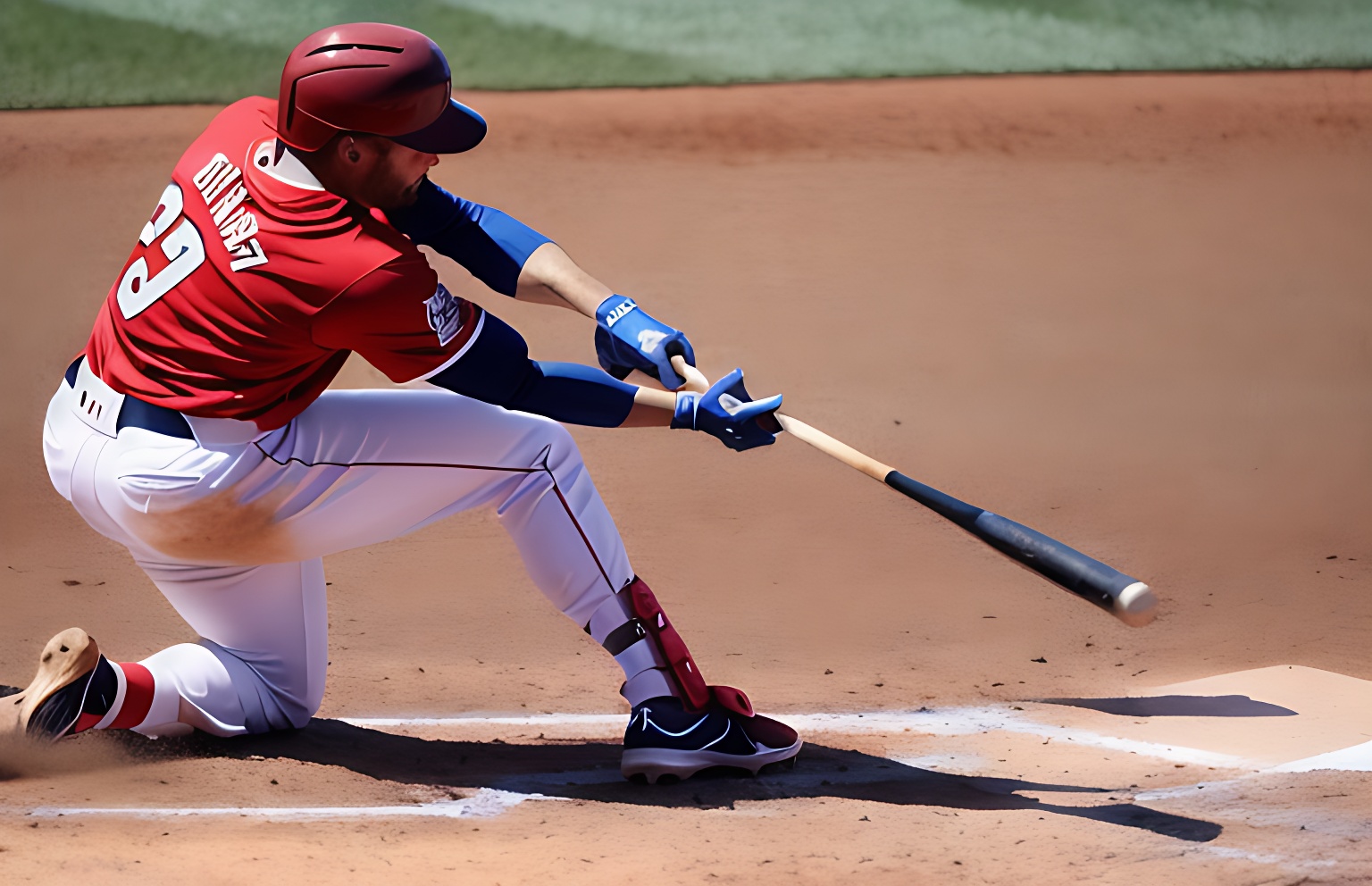How Fast Does a Baseball Come Off the Bat?
Have you ever wondered just how fast a baseball can come off the bat? Whether you’re an aspiring player or a die-hard fan, understanding the speed at which the ball leaves the bat is crucial to the game.
In the world of professional and college baseball, batters with a minimum hitting speed of 90 mph are considered successful.
In the big leagues, the average ball exit speed reaches an impressive 94 mph, while collegiate hitters maintain a slightly lower average of 91 mph.
As for high school players, the velocity ranges from 72 mph for freshmen to 83 mph for seniors.
Join us as we dive into the fascinating realm of ball exit speeds and explore the factors that contribute to this critical aspect of the game. Prepare to be amazed by the sheer power unleashed when a baseball meets a bat!
See Also: best USSSA bats
The Basics of Baseball Batting
In this section, we’ll dive into the fundamentals of baseball batting and uncover the factors that contribute to the incredible speed at which a baseball can leave the bat. Get ready to step up to the plate and discover the secrets behind those jaw-dropping home runs!
The Grip: Finding Your Sweet Spot
Before we explore the art of swinging the bat, let’s start with the foundation: the grip. A solid grip is essential for control and generating power. Players spend hours refining their grip to find that perfect balance between comfort and firmness. It’s all about finding your sweet spot, where your hands feel connected to the bat, ready to unleash explosive speed upon contact.
Stance and Balance: Ready, Set, Swing!
Once you’ve mastered the grip, it’s time to focus on your stance. Your stance sets the stage for the swing, ensuring optimal balance and weight distribution. Whether you prefer an open stance, closed stance, or something in between, finding a stance that suits your style and allows for fluid movement is crucial. With the right balance, you’ll be primed to unleash your swing with maximum force.
The Swing: Unleashing Power
Ah, the swing—the moment of truth. It’s a symphony of motion, a carefully choreographed dance between the batter and the ball. As you step into the batter’s box, your eyes lock onto the pitcher, anticipating their delivery. As the ball hurtles toward you, your body springs into action, generating an explosive swing that sends shockwaves through the air.
Timing and Coordination: The Key to Success
Timing is everything in baseball, and batting is no exception. It’s the precise coordination of your body’s movements with the speed and trajectory of the pitch that separates the great hitters from the rest. The ability to read the pitcher’s hand, judge the pitch’s speed and location, and synchronize your swing at the perfect moment is a skill honed through practice and experience.
Generating Bat Speed: Unleashing the Beast
Bat speed is the secret ingredient that propels a baseball to dizzying velocities. The faster the bat swings, the greater the potential for sheer power. Generating bat speed requires a combination of strength, technique, and explosive energy transfer. From the wind-up to the follow-through, every muscle fiber in your body contributes to the momentum that will launch the ball into the stratosphere.
Contact Point: Where Magic Happens
As your bat connects with the baseball, an explosion of kinetic energy takes place. The contact point is where the magic happens—the split-second when the ball and the bat become one. Hitting the ball on the sweet spot—a spot on the bat where maximum power is transferred—can make all the difference in how fast the ball comes off the bat. It’s the sweet symphony of perfect contact that leaves spectators and pitchers alike in awe.
The Aftermath: Ball Speed and Beyond
As the baseball soars through the air, propelled by the force of your swing, its speed becomes a testament to your batting prowess. The faster the ball leaves the bat, the harder it becomes for fielders to react and for pitchers to strategize. Ball speed has a profound impact on the game, influencing defensive positioning, outfielder reactions, and the overall excitement that electrifies the stadium.
See Also: best baseball bats under $300
Understanding Bat Speed
Buckle up, baseball enthusiasts, because, in this section, we’re going to delve into the thrilling world of bat speed! Bat speed is the secret ingredient that transforms an ordinary swing into a jaw-dropping display of power and precision. Get ready to unlock the mysteries behind the velocity at which a baseball leaves the bat!
The Need for Speed
Why is bat speed such a big deal? Well, my friend, it’s simple: the faster the bat swings, the more force it imparts on the ball upon contact. And more force means greater ball speed, sending that baseball hurtling through the air like a cannonball. Bat speed is the key to turning a routine hit into an unforgettable line drive or, better yet, a colossal home run.
Building Power and Strength
Bat speed isn’t just about swinging harder; it’s about generating explosive power through proper technique and strength. Players dedicate countless hours to building the muscles required for a lightning-fast swing. From rigorous weightlifting routines to core exercises and rotational drills, every aspect of their training is geared towards unlocking that next level of bat speed.
The Role of Technique
While sheer strength is important, it’s a technique that truly separates the sluggers from the rest of the pack. Imagine a graceful ballet dancer, fluidly moving through the steps with precision and grace. Similarly, a skilled batter combines the right sequence of movements, from the initial load to the explosive hip rotation and wrist snap, to generate maximum bat speed. It’s a symphony of motion that requires finesse and timing.
The Power of Hip Rotation
Hip rotation is like the turbo boost in a video game—it adds an extra kick to your swing. As the pitch approaches, skilled batters unleash the power of their hips, rotating them with lightning speed. This rotational force amplifies the energy transferred from the body to the bat, resulting in a faster swing and a ball that rockets off the bat with incredible velocity.
The Whip Effect
Imagine cracking a whip. The snap sound you hear is the result of energy traveling from the handle to the tip of the whip, creating a fast-moving wave. The same principle applies to bat speed. Skilled hitters utilize a whip-like motion in their swing, generating an explosive release of energy at the point of contact. This “whip effect” adds that extra zing to the bat’s speed and sends the ball flying.
Improving Reaction Time
Bat speed isn’t just about the physical aspect; it also involves mental prowess. A batter must react swiftly to the pitcher’s delivery, recognizing the type of pitch, its speed, and its location. Quick reflexes and keen eyesight are paramount. Players work on drills and exercises to improve their reaction time, allowing them to adjust their swing and maximize bat speed in the blink of an eye.
The Pursuit of Perfection
In the world of baseball, there’s always room for improvement. Even the most skilled batters constantly strive to enhance their bat speed. They analyze their swings, fine-tune their mechanics, and experiment with different training methods. The pursuit of perfection is an ongoing journey, and the rewards are seen in those blistering line drives and towering home runs.
Learn Also: best wooden baseball bats under $100
Factors Affecting Ball Exit Speed
Buckle up, baseball fans, because, in this section, we’re about to unravel the thrilling factors that influence the speed at which baseball rockets off the bat. From the pitcher’s delivery to the batter’s swing mechanics, various elements come into play, shaping the breathtaking exit speed of the ball. Get ready to explore the fascinating interplay of these factors!
The Pitcher’s Velocity and Pitch Type
It all begins with the pitcher’s arm. The speed at which they hurl the baseball toward home plate has a direct impact on the exit speed. A faster pitch demands a quicker reaction from the batter, allowing for less time to generate maximum bat speed. Moreover, the type of pitch—whether it’s a blazing fastball, a wicked curveball, or a deceptive changeup—alters the way the ball interacts with the bat, affecting its exit speed.
The Hitter’s Swing Mechanics and Timing
The batter’s swing mechanics are like a well-choreographed dance, blending power, precision, and timing. The angle of the swing, the path of the bat, and the transfer of weight—all contribute to the final exit speed of the ball. A smooth, efficient swing with proper mechanics allows for better energy transfer, resulting in a higher exit speed. Additionally, the batter’s timing in connecting with the pitch at the sweet spot plays a crucial role in maximizing ball velocity.
Ball Contact Location on the Bat
Imagine a dart hitting the bullseye—it’s all about precision. Similarly, where the ball makes contact with the bat impacts its exit speed. Hitting the sweet spot—the area on the bat with optimal energy transfer—leads to a cleaner, more powerful hit. Even a slight deviation from the sweet spot can result in a decrease in exit speed. Skilled batters strive to consistently make contact at this sweet spot, unlocking the full potential of their swing.
Bat Speed: Unleashing the Fury
Bat speed, as we’ve learned, is a game-changer. The faster the bat swings, the greater the potential for explosive ball speed. Generating bat speed involves a combination of strength, technique, and quick reflexes. A batter who can whip the bat through the strike zone with lightning speed can achieve jaw-dropping exit velocities, leaving spectators and fielders stunned.
Environmental Factors: Wind and Temperature
Mother Nature often has a say in the game of baseball. Wind speed and direction can impact the flight of the ball, altering its exit speed. A gusty tailwind can give an extra push to the ball, while a strong headwind may hinder its speed. Temperature also plays a role, as warmer weather can make the ball travel further due to reduced air density. These environmental factors add an exciting element of unpredictability to the game.
Bat-Ball Collision Efficiency
When the bat collides with the ball, the efficiency of that collision affects the exit speed. The elasticity of both the ball and the bat plays a role in determining how much energy is transferred. A more elastic collision—where less energy is lost—results in a higher exit speed. Bat material, ball construction, and other technological advancements impact this collision efficiency, influencing the velocity at which the ball leaves the bat.
Combination and Interaction of Factors
In the dynamic world of baseball, these factors do not exist in isolation. Rather, they interact and combine, creating a complex web of influences on the ball’s exit speed. The pitcher’s velocity, the batter’s swing mechanics, the contact location, the bat speed—each factor intermingles and intertwines, shaping the awe-inspiring moment when the ball explodes off the bat.
Learn Also: best youth baseball bats under $200
Conclusion
In the world of Major League Baseball (MLB), the speed at which a baseball comes off the bat, known as the exit velocity, is a critical factor in determining the success of a hit. This batted ball speed is influenced by a myriad of factors, including the pitch speed, the point of contact with the ball, and the quality of the bat used. High exit velocities are often associated with successful hits, with speeds often exceeding 100 mph.
One notable example of high exit velocity is demonstrated by MLB player Giancarlo Stanton, who consistently achieves an average exit speed well above the league’s norm. His ability to hit a ball with such force is a testament to his skill and the importance of speed off the bat in the game. The tip of the bat, where contact with the ball is ideally made, plays a significant role in achieving these high speeds.
The speed of the pitch also contributes to the exit velocity. A pitched ball traveling at a high speed would, upon contact, contribute to a higher mph of exit velocity. This is why measuring exit speed has become a crucial part of the game, not just in baseball, but also in softball. The speed off the bat can significantly influence the batting average of a player, making it a key performance indicator in the sport.
In conclusion, the exit velocity is the speed at which the ball leaves the bat after contact. This speed, which can be influenced by the pitch speed, the quality of the bat, and the point of contact on the bat, is a critical factor in the success of a hit.
The highest exit velocities often result in the most successful hits, with speeds frequently exceeding 100 mph. Whether you’re an MLB player like Giancarlo Stanton or a budding baseball or softball enthusiast, understanding and improving your exit velocity can significantly enhance your performance on the field.
FAQs
Is a wood bat faster than a bat?
No, a wood bat is not faster than a metal bat. The speed at which a bat swings is primarily determined by the strength and technique of the batter, rather than the material of the bat. However, there may be slight differences in the weight and balance between wood and metal bats, which can affect a player’s swing speed. Some players may find it easier to generate faster bat speeds with a well-balanced metal bat due to its lighter weight, while others may prefer the feel and control of a wood bat. Ultimately, the speed of the swing depends on the player’s individual mechanics and preferences, regardless of the type of bat used.
What does bat speed mean?
Bat speed refers to the velocity at which a baseball bat travels through the strike zone during a swing. It is a crucial factor in generating power and driving the ball with force. A higher bat speed allows hitters to make solid contact, increasing the chances of hitting the ball harder and farther. It is influenced by various factors, including a player’s strength, technique, and timing. Improving bat speed is a key focus for baseball players aiming to enhance their offensive performance and maximize their hitting potential.
Does bat speed affect exit velocity?
Yes, bat speed has a direct impact on the exit velocity of a batted ball. A higher bat speed translates into a higher exit velocity, which is the speed at which the ball leaves the bat after contact. When a hitter generates greater bat speed, it results in a more powerful transfer of energy from the bat to the ball. This increased energy transfer leads to a faster and more forceful ball flight, making it more challenging for fielders to react and increasing the likelihood of extra-base hits or home runs. Consequently, improving bat speed is a crucial factor in maximizing the offensive potential of a baseball player.
What is an MLB exit velocity?
An MLB exit velocity is the speed at which a ball off the bat travels in miles per hour (mph). This is measured from the moment the ball makes contact with the bat until it reaches a point on the field.
How fast can a baseball be hit?
The fastest recorded speed for a baseball coming off the bat is 123.4 mph, which was hit by Giancarlo Stanton in 2018. The average speed for a major league baseball hit is around 85 mph.
Does a heavier bat mean the ball will be hit faster?
No, a heavier bat does not necessarily mean the ball will be hit faster. In fact, using a proper bat that is comfortable for the player can actually result in a higher exit speed. Finding the ideal bat weight is a matter of personal preference and proper technique.
How does the impact point affect the speed of the ball off the bat?
The impact point on the bat can affect the speed, with the sweet spot being the most efficient point. Hitting coaches often work with players on finding the best impact point to maximize their swing and increase the exit speed.
What is a good exit speed for high school baseball?
The average exit speed for high school baseball players is around 75 mph. However, this can vary based on age, skill level, and other factors.
How does the weather affect the ball off the bat?
The ball off the bat tends to travel faster in warm and dry weather conditions due to the air density. Humidity, wind, and altitude can also affect the speed and trajectory of the ball.
Is there a difference in speed between baseball and softball?
Yes, there is a difference in the speed of the ball off the bat in baseball and softball. The weight and size of the balls are different, with softball being larger and heavier. As a result, the exit speed for softball is generally lower than for baseball.
How does the speed of the pitch affect the ball off the bat?
The speed of the pitch can affect the exit speed, with faster pitches often resulting in a higher exit speed. However, the type of pitch and the skill of the hitter can also play a role.







